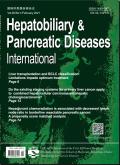Effects of triggers of senescence and senolysis in murine pancreatic cancer cells
IF 4.4
3区 医学
Q2 GASTROENTEROLOGY & HEPATOLOGY
Hepatobiliary & Pancreatic Diseases International
Pub Date : 2024-12-01
DOI:10.1016/j.hbpd.2024.06.001
引用次数: 0
Abstract
Background
The combination of senescence triggers with senolytic drugs is considered a promising new approach to cancer therapy. Here, we studied the efficacy of the genotoxic agent etoposide (Eto) and irradiation in inducing senescence of Panc02 pancreatic cancer cells, and the capability of the Bcl-2 inhibitor navitoclax (ABT-263; Nav) to trigger senolysis.
Methods
Panc02 cells were treated with Eto or irradiated with 5–20 Gy before exposure to Nav. Cell survival, proliferation, and senescence were assessed by trypan blue staining, quantification of DNA synthesis, and staining of senescence-associated β-galactosidase (SA-β-Gal)-positive cells, respectively. Levels of mRNA were determined by real-time polymerase chain reaction, and protein expression was analyzed by immunoblotting. Panc02 cells were also grown as pancreatic tumors in mice, which were subsequently treated with Eto and Nav.
Results
Eto and irradiation had an antiproliferative effect on Panc02 cells that was significantly or tendentially enhanced by Nav. In vivo, Eto and Nav together, but not Eto alone, significantly reduced the proportion of proliferating cells. The expression of the senescence marker γH2AX and tumor infiltration with T-cells were not affected by the treatment. In vitro, almost all Eto-exposed cells and a significant proportion of cells irradiated with 20 Gy were SA-β-Gal-positive. Application of Nav reduced the percentage of SA-β-Gal-positive cells after irradiation but not after pretreatment with Eto. In response to triggers of senescence, cultured Panc02 cells showed increased protein levels of γH2AX and the autophagy marker LC3B-II, and higher mRNA levels of Cdkn1a, Mdm2, and PAI-1, while the effects of Nav were variable.
Conclusions
In vitro and in vivo, the combination of senescence triggers with Nav inhibited tumor cell growth more effectively than the triggers alone. Our data also provide some evidence for senolytic effects of Nav in vitro.
诱发小鼠胰腺癌细胞衰老和衰亡的因素的影响。
背景:衰老诱导剂与溶癌药物的结合被认为是一种很有前景的癌症治疗新方法。在此,我们研究了基因毒性药物依托泊苷(Eto)和辐照在诱导 Panc02 胰腺癌细胞衰老方面的功效,以及 Bcl-2 抑制剂 navitoclax(ABT-263;Nav)触发衰老的能力:方法:在暴露于Nav之前,用Eto或5-20 Gy照射Panc02细胞。细胞存活、增殖和衰老分别通过胰蓝染色、DNA合成定量和衰老相关β-半乳糖苷酶(SA-β-Gal)阳性细胞染色进行评估。mRNA水平通过实时聚合酶链反应测定,蛋白质表达通过免疫印迹分析。还将 Panc02 细胞培养成小鼠的胰腺肿瘤,随后用 Eto 和 Nav 对其进行治疗:结果:Eto 和辐照对 Panc02 细胞具有抗增殖作用,而 Nav 能显著或有倾向性地增强这种作用。在体内,Eto 和 Nav 的共同作用(而非 Eto 单独作用)显著降低了增殖细胞的比例。衰老标记物 γH2AX 的表达和 T 细胞对肿瘤的浸润不受处理的影响。在体外,几乎所有暴露于 Eto 的细胞和相当一部分接受 20 Gy 照射的细胞都呈 SA-β-Gal 阳性。应用 Nav 能降低辐照后 SA-β-Gal 阳性细胞的百分比,但不能降低 Eto 预处理后的百分比。针对衰老的触发因素,培养的 Panc02 细胞显示出 γH2AX 和自噬标记物 LC3B-II 蛋白水平的升高,以及 Cdkn1a、Mdm2 和 PAI-1 mRNA 水平的升高,而 Nav 的效果则各不相同:结论:在体外和体内,衰老触发器与 Nav 的结合比单独使用触发器更有效地抑制肿瘤细胞的生长。我们的数据还为 Nav 在体外的衰老效应提供了一些证据。
本文章由计算机程序翻译,如有差异,请以英文原文为准。
求助全文
约1分钟内获得全文
求助全文
来源期刊
CiteScore
5.40
自引率
6.10%
发文量
152
审稿时长
3.0 months
期刊介绍:
Hepatobiliary & Pancreatic Diseases International (HBPD INT) (ISSN 1499-3872 / CN 33-1391/R) a bimonthly journal published by First Affiliated Hospital, Zhejiang University School of Medicine, China. It publishes peer-reviewed original papers, reviews and editorials concerned with clinical practice and research in the fields of hepatobiliary and pancreatic diseases. Papers cover the medical, surgical, radiological, pathological, biochemical, physiological and historical aspects of the subject areas under the headings Liver, Biliary, Pancreas, Transplantation, Research, Special Reports, Editorials, Review Articles, Brief Communications, Clinical Summary, Clinical Images and Case Reports. It also deals with the basic sciences and experimental work. The journal is abstracted and indexed in SCI-E, IM/MEDLINE, EMBASE/EM, CA, Scopus, ScienceDirect, etc.

 求助内容:
求助内容: 应助结果提醒方式:
应助结果提醒方式:


